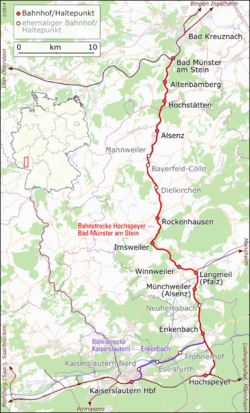History
From 1859 there was a continuous north-south trunk line from the Rhineland via Rhenish Hesse to Ludwigshafen in the form of the West Rhine Railway between Cologne and Mainz and the Mainz–Ludwigshafen railway. But the lines running via Mainz were indirect, so plans emerged for the building of a shorter line from about Bingen am Rhein south along the Alsenz to the catchment area of the Donnersberg via Enkenbach and from there towards Neustadt. In order to take account of the interests of the city of Kaiserslautern, a connection curve was created south of Fischbach to Hochspeyer to allow appropriate movements. The Hochspeyer–Winnweiler section was opened on 29 October 1870. The Winnweiler–Bad Munster am Stein section followed on 16 May 1871. [2]
After the Franco-Prussian War of 1870 and 1871 there was an increased interest in building strategic railways in southwest Germany. There were demands for a direct connection between Kaiserslautern and Enkenbach, as the existing route via Hochspeyer was considered too roundabout for this purpose. The city of Kaiserslautern made land available for the proposed line. The connection between Kaiserslautern and Enkenbach was opened on 15 May 1875. [2] The line included the stations of Kaiserslautern Nord and Eselsfürth.
Development up to the Second World War (1875–1945)
Alsenz Valley Railway was operated by the Palatine Northern Railway Company (Gesellschaft der Pfälzischen Nordbahnen) and functioned as its main line.
The Bad Münster–Enkenbach section was frequented by the 1920s by long-distance trains on the Cologne–Bingen–Neustadt–Landau–Wissembourg–Strasbourg route. However, after Alsace was ceded to France after the First World War, the line lost much of its traffic towards Neustadt. Since the Enkenbach–Eselsfürth–Kaiserslautern route is shorter than the route via Hochspeyer, most trains approach Kaiserslautern via Eselsfürth.
After the Zeller Valley Railway (Zellertalbahn) was completed from Langmeil to Monsheim) in 1873 and the Donnersberg Railway (Donnersbergbahn) was completed from Alzey to Marnheim in 1874, the section between Kaiserslautern and Langmeil also carried long-distance trains to the Rhine-Main area via Worms to Frankfurt or via Alzey to Mainz. The Eis Valley Railway (Eistalbahn) was opened in 1876 from Grünstadt to Eisenberg and connected to Enkenbach in 1932. Some of its services connected with Kaiserslautern.
In 1942, during the Second World War, a major accident occurred on the line: in the morning a military train and a freight train collided with each other in Enkenbach. The incident killed two people and wounded many others. A greater tragedy was avoided because the first two carriages of the military train were only lightly occupied. [2]
Deutsche Bundesbahn and Deutsche Bahn (since 1945)
After the Second World War, several intermediate stops (Neuhemsbach, Dielkirchen, Bayerfeld-Colln, Mannweiler, Ebernburg) were abandoned due to low patronage. After all the connecting lines, the Eis Valley Railway, the Zeller Valley Railway and the Donnersberg Railway, had been closed for passenger services between 1983 and 1994, the Alsenz Valley Railway was the only line that was in full operation in the Donnersbergkreis. The narrow-gauge railway to Obermoschel had already been closed in the 1930s.
In 1970, the Hochstein tunnel, also called the Eisenschmelz tunnel, located at kilometre 19, was converted into a cutting. [3] [4] Until 1990 the line was also served by a Schnellzug (express) on the Paris Est–Metz–Saarbrücken–Kaiserslautern–Bad Kreuznach–Mainz–Frankfurt am Main route, which was operated until the mid-1970s with SNCF DEV Inox cars and then by Corail cars. Between 1988 and 1990 they were partially replaced by express services from Pirmasens via Kaiserslautern and Bingen to Cologne. Since then, these trains have been abandoned and the Alsenz Valley Railway has lost all long-distance services.
In 1999, a new station was set up in Münchweiler an der Alsenz between Langmeil and the abandoned station of Neuhemsbach. Consequently, the Langmeil station, which had previously been used by Münchweiler's population, lost its importance, which led to it being abandoned in late 2006. Even with the recommencement of services on Sundays and public holidays in 2001 on the now reactivated Zeller Valley Railway, trains no longer serve this once important junction station.
As part of the expanded Rhineland-Palatinate integrated regular-interval timetable being introduced from 2015, new Regional-Express services will be introduced on the Koblenz–Bingen–Bad Kreuznach–Kaiserslautern route (from December 2016) and the Mainz–Bad Kreuznach–Kaiserslautern route (from December 2014). They will both run on the Alsenz Valley Railway and be operated by Netinera. [5]
Operations
Deutsche Bahn operates hourly services on the line. It is listed in the Deutsche Bahn timetable (KBS) as line 672. Until the timetable change in December 2008, the services continued over the Biebermühl Railway to Pirmasens; since then only Regionalbahn services have run between Kaiserslautern and Bingen.
From Kaiserslautern to Alsenz, the line runs within the area of the Verkehrsverbund Rhein-Neckar (Rhine-Neckar Transport Association, VRN) and from Hochstätten to Bad Münster it is within the area of the Rhein-Nahe Nahverkehrsverbund (Rhine-Nahe Transport Association, RNN).
On Sundays and public holidays in the summer, the Rheintalexpress runs on the Bingen–Enkenbach section to Karlsruhe and the Weinstraßen-Express runs to Wissembourg, each stopping in Enkenbach, Rockhausen, Bad Münster and Bad Kreuznach and each consisting of push–pull trains hauled by class 218 locomotives or class 628 diesel multiple units. Furthermore, the Langmeil–Hochspeyer section is served in the summer on Sundays and public holidays by daily services on the Zeller Valley Railway route.
Rolling stock
In 2000, 628 diesel multiple units were replaced by modern Talent railcars of class 643. Since the timetable change in December 2008, Desiro trains of class 642 also operate. Previously, local services were mostly operated with Silberling carriages. These were hauled diesel locomotives of class 218; in the winter coupled French locomotives were also sometimes used.

Winnweiler is a municipality in the Donnersbergkreis, in Rhineland-Palatinate, Germany. It is situated on the upper course of the river Alsenz, approx. 15 km (9.3 mi) north-east of Kaiserslautern. Winnweiler is the seat of the Verbandsgemeinde Winnweiler. Winnweiler station is on the Alsenz Valley Railway (Alsenztalbahn), running between Hochspeyer and Bad Münster am Stein.
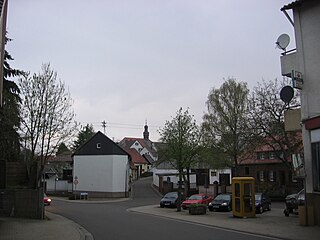
Sembach is a municipality in the district of Kaiserslautern in the state of Rhineland-Palatinate, Germany. It forms part of the Verbandsgemeinde of Enkenbach-Alsenborn. The town is nestled in the Palatinate Forest Nature Park between Kaiserslautern and Donnersbergkreis. Sembach was first mentioned in the 13th century, in a document about a donation to the monastery of Enkenbach.

The Mannheim–Saarbrücken railway is a railway in the German states of Baden-Württemberg, Rhineland-Palatinate and the Saarland that runs through Ludwigshafen am Rhein, Neustadt an der Weinstraße, Kaiserslautern, Homburg and St. Ingbert It is the most important railway line that runs through the Palatinate. It serves both passenger and freight transport and carries international traffic.
The Palatine Northern Railways Company – abbreviated to Palatine Northern Railway - was founded on 17 April 1866 as the last of the three major private railway companies in the Bavarian province of the Palatinate.
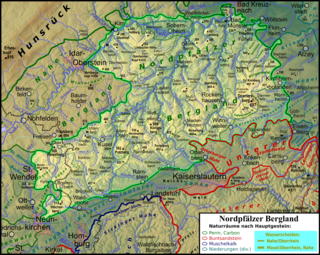
The North Palatine Uplands, sometimes shortened to Palatine Uplands, is a low mountain range and landscape unit in the German state of Rhineland-Palatinate and belongs mainly to the Palatinate region. It is part of the Saar-Nahe Uplands.

Kaiserslautern Hauptbahnhof is a through-station in the German city of Kaiserslautern and one of seven stations in the city. It is a stop on the Rhine-Neckar S-Bahn and Deutsche Bahn’s Intercity-Express network and a hub for all the regional trains of the western Palatinate. On 10 June 2007, the Rhealys high-speed rail consortium established a service with a stop in Kaiserslautern, reducing travel time to Paris to two and a half hours.

The Nahe Valley Railway is a two-track, partially electrified main line railway in the German states of Rhineland-Palatinate and Saarland, which runs for almost 100 kilometres along the Nahe. It was built by the Rhine-Nahe Railway Company and connects Bingen am Rhein on the Left Rhine line with Saarbrücken. It was opened between 1858 and 1860 and is one of the oldest railways in Germany. The section south of Bad Kreuznach is part of the regionally important transport corridor between the two major cities of Mainz and Saarbrücken.

Neustadt (Weinstr) Hauptbahnhof – called Neustadt a/d. Haardt until 1935 and from 1945 until 1950 – is the central station of in the city of Neustadt in the German state of Rhineland-Palatinate. In addition to the Hauptbahnhof, Rhine-Neckar S-Bahn services stop at Neustadt (Weinstr) Böbig halt (Haltepunkt). Mußbach station and Neustadt (Weinstr) halt, opened on 19 November 2013, are also located in Neustadt.

The Gau Algesheim–Bad Kreuznach railway is a twin-track, non-electrified main line railway in the German state of Rhineland-Palatinate. It connects Gau-Algesheim on the Left Rhine line with Bad Kreuznach on the Nahe Valley Railway (Nahetalbahn) and is thus part of a regionally important transport corridor between the two state capitals cities of Mainz and Saarbrücken in the Saarland.

Bad Münster am Stein station is a station at a railway junction in Bad Münster am Stein-Ebernburg, a district of Bad Kreuznach in the German state of Rhineland-Palatinate. The station building, dating from about 1910, is protected as a monument. It is classified by Deutsche Bahn as a category 4 station. The station is located in the network of the Rhein-Nahe-Nahverkehrsverbund and belongs to fare zone 401. Its address is: Berliner Straße 20.

The Glan Valley Railway is a non-electrified line along the Glan river, in the German state of Rhineland-Palatinate. It consists of the Glan-Münchweiler–Altenglan section, which was built as part of the Landstuhl–Kusel railway and sections that were built later for military reasons: Homburg–Glan-Münchweiler, Altenglan–Staudernheim and Odernheim–Bad Münster am Stein. The line had strategic importance, otherwise traffic was rather low, except on the Glan Munchweiler–Altenglan section.

Glan-Münchweiler station is the station of the town of Glan-Münchweiler in the German state of Rhineland-Palatinate. It is classified by Deutsche Bahn as a category 6 station and has two platforms and sidings. The station is located in the network area of the Verkehrsverbund Rhein-Neckar. The address of the station is Bahnhofstraße 3.
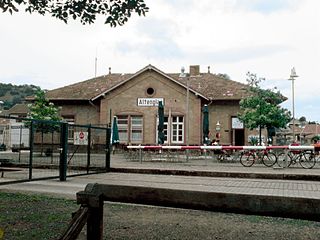
Altenglan station is the station of the village of Altenglan in the German state of Rhineland-Palatinate. It is classified by Deutsche Bahn as a category 6 station. and has two platforms and sidings. The station is located in the network area of the Verkehrsverbund Rhein-Neckar. The address of the station is Bahnhofstraße 45.
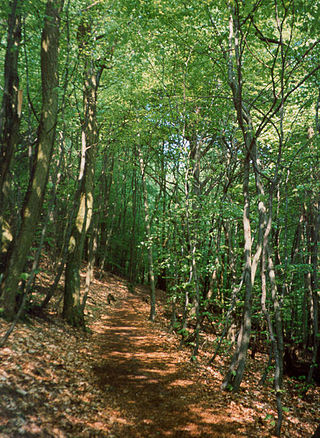
Walking routes in the Palatine Forest fall into two categories. The first are longer walking routes, most of which are maintained by the Palatine Forest Club, or PWV, and which are linked to the national and international network of long distance paths. The second category are those local circular walks and themed walking routes, some of which are of wider regional importance, and which are maintained by municipal authorities. The Palatine Forest, as part of the Palatine Forest-North Vosges Biosphere Reserve, is an important conservation area. As a result, the Palatine Forest, the bunter sandstone landscape of the Palatine Forest Nature Park, the castles in the Dahner Felsenland and the cross-border paths into Alsace and the Vosges make the region particularly popular with ramblers and walkers.
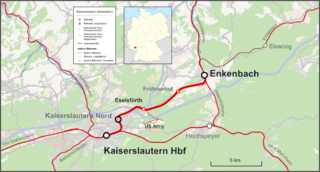
The Kaiserslautern–Enkenbach railway is a single-track main line in the Western Palatinate. It runs within the area of the Verkehrsverbund Rhein-Neckar. It was built in 1875 to shorten the route for trains on the Alsenz Valley Railway (Alsenztalbahn) running to Kaiserslautern. In the following years, several express trains ran over this line. Passenger traffic was discontinued in 1987, but it was reactivated ten years later.

Enkenbach station is the only station in Enkenbach-Alsenborn in the German state of Rhineland-Palatinate. It has two platforms tracks and is located in the network of the Verkehrsverbund Rhein-Neckar and belongs to fare zone 828. Its address is Bahnhofstraße 2.

Hochspeyer station – originally officially Neuhochspeyer or Neu-Hochspeyer – is the station of the town of Hochspeyer in the German state of Rhineland-Palatinate. Deutsche Bahn classifies it as belonging to category 4 and it has four platform tracks. The station is located in the network of the Verkehrsverbund Rhein-Neckar and belongs to fare zone 100. Its address is Bahnhofstraße 1.
Winnweiler station is the station of the town of Winnweiler in the German state of Rhineland-Palatinate. Deutsche Bahn classifies it as a category 6 station and it has two platforms.

Alsenz station is the station of the town of Alsenz in the German state of Rhineland-Palatinate. Deutsche Bahn classifies it as a category 6 station and it has two platforms. Its address is Bahnhofstraße 1.

Weidenthal station is the station of the town of Weidenthal in the German state of Rhineland-Palatinate. It lies on the Mannheim–Saarbrücken railway, which essentially consists of the Pfälzischen Ludwigsbahn, which historically connected Ludwigshafen and Bexbach. It was opened on 25 August 1849, with the Kaiserslautern–Frankenstein section of the Ludwig Railway. Its entrance building is a protected monument.
